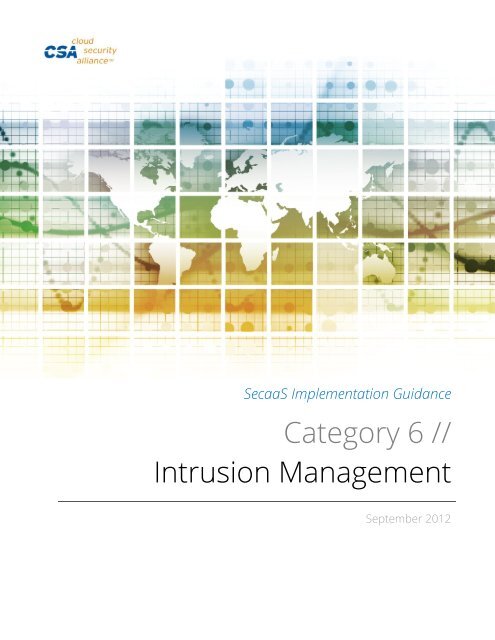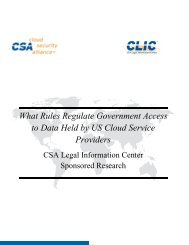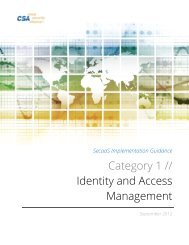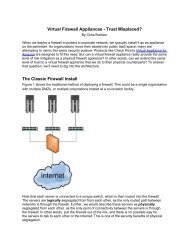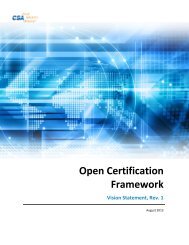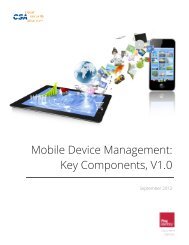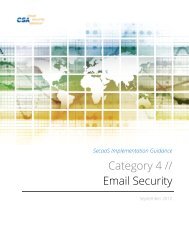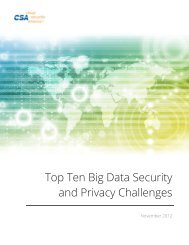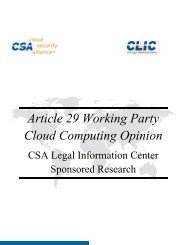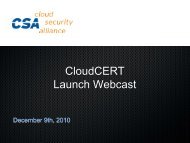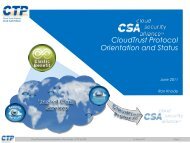Download - Cloud Security Alliance
Download - Cloud Security Alliance
Download - Cloud Security Alliance
- No tags were found...
Create successful ePaper yourself
Turn your PDF publications into a flip-book with our unique Google optimized e-Paper software.
SecaaS Implementation GuidanceCategory 6 //Intrusion ManagementSeptember 2012
CLOUD SECURITY ALLIANCE SecaaS Implementation Guidance, Category 6: Intrusion Management© 2012 <strong>Cloud</strong> <strong>Security</strong> <strong>Alliance</strong>All rights reserved. You may download, store, display on your computer, view, print, and link to the <strong>Cloud</strong><strong>Security</strong> <strong>Alliance</strong> <strong>Security</strong> as a Service Implementation Guidance at http://www.cloudsecurityalliance.org,subject to the following: (a) the Guidance may be used solely for your personal, informational, non-commercialuse; (b) the Guidance may not be modified or altered in any way; (c) the Guidance may not be redistributed; and(d) the trademark, copyright or other notices may not be removed. You may quote portions of the Guidance aspermitted by the Fair Use provisions of the United States Copyright Act, provided that you attribute the portionsto the <strong>Cloud</strong> <strong>Security</strong> <strong>Alliance</strong> <strong>Security</strong> as a Service Implementation Guidance Version 1.0 (2012).© Copyright 2012, <strong>Cloud</strong> <strong>Security</strong> <strong>Alliance</strong>. All rights reserved. 2
CLOUD SECURITY ALLIANCE SecaaS Implementation Guidance, Category 6: Intrusion ManagementContentsForeword ....................................................................................................................................................................5Letter from the Co-Chairs...........................................................................................................................................6Acknowledgments ......................................................................................................................................................71.0 Introduction..........................................................................................................................................................81.1 Intended Audience ...........................................................................................................................................81.2 Scope ................................................................................................................................................................81.2.1 Functional Areas Covered..........................................................................................................................91.2.2 <strong>Cloud</strong>-Delivered Versus Traditional Intrusion Services .............................................................................91.2.3 Related SecaaS Categories and Guidance .................................................................................................92.0 Requirements Addressed .................................................................................................................................. 102.1 Intrusion Detection and Response ................................................................................................................ 102.1.1 Techniques and Strategies...................................................................................................................... 102.1.2 Correlation and Response ...................................................................................................................... 122.2 Intrusion Management.................................................................................................................................. 122.2.1 Element Management and Incident Reporting...................................................................................... 132.2.2 Infrastructure for IM SecaaS................................................................................................................... 132.2.3 Service Standards and Functions............................................................................................................ 132.3 Service Levels and Business Model Requirements........................................................................................ 133.0 Considerations and Concerns............................................................................................................................ 153.1 Considerations............................................................................................................................................... 153.1.1 Service Level Agreement Language........................................................................................................ 153.1.2 Financial Considerations......................................................................................................................... 153.1.3 Technical Considerations........................................................................................................................ 153.1.4 Architecture Considerations................................................................................................................... 153.1.5 <strong>Security</strong> Considerations.......................................................................................................................... 163.2 Concerns........................................................................................................................................................ 163.2.1 Gaps with the Provider Solution............................................................................................................. 163.2.2 Integration Concerns .............................................................................................................................. 163.2.3 Environmental and <strong>Security</strong> Concerns ................................................................................................... 17© Copyright 2012, <strong>Cloud</strong> <strong>Security</strong> <strong>Alliance</strong>. All rights reserved. 3
CLOUD SECURITY ALLIANCE SecaaS Implementation Guidance, Category 6: Intrusion Management3.2.4 Technical Performance Concerns........................................................................................................... 173.2.5 General Challenges................................................................................................................................. 173.2.6 Specific to <strong>Cloud</strong> Consumers .................................................................................................................. 173.2.7 Specific to <strong>Cloud</strong> Service Providers ........................................................................................................ 174.0 Implementation................................................................................................................................................. 194.1 Architectural Overview.................................................................................................................................. 194.1.1 Intrusion Detection Framework ............................................................................................................. 194.1.2 Intrusion Detection and Protection Architecture................................................................................... 214.1.3 Network-Based Detection ...................................................................................................................... 224.1.4 Virtualization Layer Detection................................................................................................................ 254.1.5 Client-Based Detection........................................................................................................................... 274.1.6 Application Layer Detection ................................................................................................................... 284.1.7 Hybrid Solutions ..................................................................................................................................... 294.2 <strong>Cloud</strong>-Provided IM SecaaS Implementation.................................................................................................. 314.2.1 Intrusion Management Infrastructure ................................................................................................... 314.2.2 Policy Implementation............................................................................................................................ 315.0 References and Useful Links.............................................................................................................................. 335.1 References..................................................................................................................................................... 335.2 Useful Links.................................................................................................................................................... 33© Copyright 2012, <strong>Cloud</strong> <strong>Security</strong> <strong>Alliance</strong>. All rights reserved. 4
CLOUD SECURITY ALLIANCE SecaaS Implementation Guidance, Category 6: Intrusion ManagementForeword<strong>Cloud</strong> Computing represents one of the most significant shifts in information technology manyof us are likely to see in our lifetimes. We are reaching the point where computing functions as a utility,promising innovations yet unimagined. The major roadblock to full adoption of <strong>Cloud</strong> Computing has beenconcern regarding the security and privacy of information.Much work has been done regarding the security of the cloud and data within it, but until now, there have beenno best practices to follow when developing or assessing security services in an elastic cloud model—a modelthat scales as client requirements change.One mission of the <strong>Cloud</strong> <strong>Security</strong> <strong>Alliance</strong> is to provide education on the uses of <strong>Cloud</strong> Computing to helpsecure all other forms of computing. To aid both cloud customers and cloud providers, the CSA SecaaS WorkingGroup is providing Implementation Guidance for each category of <strong>Security</strong> as a Service, as delineated in theCSA’s SecaaS Defined Categories of Service. <strong>Security</strong> as a Service was added, as Domain 14, to version 3 of theCSA Guidance.<strong>Cloud</strong> <strong>Security</strong> <strong>Alliance</strong> SecaaS Implementation Guidance documents are available athttps://cloudsecurityalliance.org/research/working-groups/security-as-a-service/.We encourage you to download and review all of our flagship research at http://www.cloudsecurityalliance.org.Best regards,Jerry Archer Alan Boehme Dave CullinaneNils Puhlmann Paul Kurtz Jim ReavisThe <strong>Cloud</strong> <strong>Security</strong> <strong>Alliance</strong> Board of Directors© Copyright 2012, <strong>Cloud</strong> <strong>Security</strong> <strong>Alliance</strong>. All rights reserved. 5
CLOUD SECURITY ALLIANCE SecaaS Implementation Guidance, Category 6: Intrusion ManagementLetter from the Co-Chairs<strong>Security</strong> as a Service is a specialized area categorized two years ago as growing rapidly and in unboundpatterns. Vendors were struggling. Consumers were struggling. Each offering had its own path. We felt it wasurgent to address the needs and concerns common to the implementation of <strong>Security</strong> as a Service in its manyforms.The Defined Categories of Service helped clarify the functionalities expected from each Category. In this series,we hope to better define best practices in the design, development, assessment and implementation of today’sofferings.We want to thank all of the many contributors worldwide who have worked so hard to produce these papersproviding guidance for best practices in <strong>Cloud</strong> Computing <strong>Security</strong>. Many have been with the <strong>Security</strong> as aService Working Group since the beginning; many others joined in this effort. Each has spent countless hoursconsidering, clarifying, writing and/or editing these papers. We hope they help move forward toward thoseunimagined innovations.Sincerely,Kevin Fielder and Cameron SmithSecaaS Working Group Co-Chairs© Copyright 2012, <strong>Cloud</strong> <strong>Security</strong> <strong>Alliance</strong>. All rights reserved. 6
CLOUD SECURITY ALLIANCE SecaaS Implementation Guidance, Category 6: Intrusion ManagementAcknowledgmentsChairTim Owen, Secure Mission SolutionsContributorsGirish Bhat, Wave SystemsPhil Cox, RightscaleRobert Gutcho, SymantecBernd Jäger, ColtPeer ReviewersJim Brigham, EMC/RSAJustin Forster, Trend MicroJohn Linn, EMC/RSAJean PawlukRobert Polansky, EMC/RSASaid Tabet, EMC/RSACSA Global StaffAaron Alva, Research InternVicki Hahn, Technical Writer/EditorLuciano JR Santos, Research DirectorKendall Scoboria, Graphic DesignerEvan Scoboria, WebmasterJohn Yeoh, Research Analyst© Copyright 2012, <strong>Cloud</strong> <strong>Security</strong> <strong>Alliance</strong>. All rights reserved. 7
CLOUD SECURITY ALLIANCE SecaaS Implementation Guidance, Category 6: Intrusion Management1.0 IntroductionThe methods of intrusion detection, prevention and response in physical environments have matured over thelast decade. However, the growth of virtualization and massive multi-tenancy is creating new targets forintrusion due to the complexity of access and difficulty in monitoring all interconnecting points betweensystems, containers, applications, and data sets. This raises many questions about the appropriateinfrastructure, processes, and strategy for enacting detection and response to intrusion in a cloud environment,or even in a traditional environment with intrusion management services delivered via the cloud.As if the difficulty of employing intrusion capabilities in the traditional enterprise were not enough, limitationson visibility, complexity caused by architectural incongruity, and complications such as encryption, data accessand format, and multiple administrative boundaries make for even more difficult choices and reduced ability todeliver the service in a highly virtualized environment, or from a cloud to protect a traditional environment.Because of the limited market maturity and lack of widely accepted best practices, this document providesimplementation guidelines for cloud-based intrusion management service of multiple flavors—in the cloud,through the cloud, or from the cloud—focusing on the basic tenets of service and architecture rather thansolutions. Its intent is to describe the functional areas of any IM SecaaS service, critical elements for effectivedelivery, and options for deployment, along with the minimum standards necessary to integrate those servicessuccessfully within the larger SecaaS model and security architecture framework.While further development of standards are ongoing, these instruction sets and guidelines are designed toensure that the basis for a service are defined sufficiently so that service providers, third-party solutionsproviders, and consumers are clearly in synch when crafting contract and service level language or ordering andexecuting the service.1.1 Intended AudienceThe intended audience is the gamut of IT professionals considering cloud-based security services. However, thebulk of the material contained herein is written with a technical audience in mind—engineers, implementers,operators, technical assessors of planned and implemented offerings, and the technical representatives ofconsumers of the services and functions.1.2 ScopeThis guidance covers the requirements and capabilities, considerations and concerns, and implementationcriteria of cloud-provided Intrusion Detection, Response, and Management services. The material is designed toensure all three potential perspectives are considered and that the standards are translatable to therequirements of each participant in the service. The content is also presented from the context of providing theservice from a cloud, through a cloud, or with cloud enhanced capabilities. This guidance does not specificallyaddress complete architectures, although they must be modeled to some degree in order to provide sufficientbackdrop to describe implementation strategies and functional standards.© Copyright 2012, <strong>Cloud</strong> <strong>Security</strong> <strong>Alliance</strong>. All rights reserved. 8
CLOUD SECURITY ALLIANCE SecaaS Implementation Guidance, Category 6: Intrusion Management1.2.1 Functional Areas CoveredDetailed in following sections, the main functional areas covered by this guide include the standard functionsand practices required to manage:Intrusion Detection through:o Network Traffic Inspection, Behavioral Analysis, and Flow Analysis,o Operating System, Virtualization Layer, and Host Process Events,o Application Layer Events, ando Correlation Techniques, and other Distributed and <strong>Cloud</strong>-Based Capabilities.Intrusion Response using:o Automatic, Manual, or Hybrid Mechanisms, and/oro Technical, Operational, and Process Mechanisms.Intrusion Management Service Infrastructure, including:o Detection and Response Architectures and Design Requirements,o Intrusion Management Service Components,o Application, process, and data requirements,o Skills and Training, ando Governance, Regulatory, and Compliance Issues (data privacy)1.2.2 <strong>Cloud</strong>-Delivered Versus Traditional Intrusion ServicesThe content is focused on describing parallels and distinctions between cloud-delivered versus traditionalenterprise intrusion capabilities, drawing attention to the requirements, standards, options, and considerationsfor how to deploy such services to various target environments (IaaS, PaaS, SaaS). Likewise, given thefundamental assumption that a provider environment must first be secured before effectively delivering<strong>Security</strong> as a Service to another environment, nuances in requirements for delivery across the variousconfigurations (provider cloud, third-party, private and on-site cloud, or non-cloud) are also detailed. In the end,there are no unifying architectures or generalized standards to convey, but unifying principles and generalizedqualifications and strategies are depicted.1.2.3 Related SecaaS Categories and GuidanceIn order to keep content focused on cloud-delivered Intrusion Management Services—the infrastructurerequired to identify and respond to potential intrusion, delivered in the cloud, through the cloud, or from thecloud—this guidance does not cover specific algorithms or techniques of intrusion detection, or specificmethods of intrusion prevention. Some facets of Intrusion Management (IM), like Infrastructure Protection andResiliency, are more detailed in SecaaS Category 10 Network <strong>Security</strong>. This guidance does not address themanagement of security events or correlation (covered more in depth in SecaaS Category 7 <strong>Security</strong> Incidentand Event Management [SIEM]) other than the control and process for security architecture response andadaption and the need for SIEM integration and interfaces for input/output to other SecaaS services such asCategory 3 Web <strong>Security</strong>.© Copyright 2012, <strong>Cloud</strong> <strong>Security</strong> <strong>Alliance</strong>. All rights reserved. 9
CLOUD SECURITY ALLIANCE SecaaS Implementation Guidance, Category 6: Intrusion Management2.0 Requirements AddressedIn order to offer guidance and minimum requirements to cover the gamut of potential offerings and capabilities,a clear depiction of the requirements to be met or problems to be solved must be presented first. This sectionaddresses the purpose of intrusion detection, response, and management; the functional areas, components,and capabilities used to meet those requirements; the complexities of various target environments; as well asthe nuances for delivering the services in the cloud, through the cloud, and from the cloud.2.1 Intrusion Detection and ResponseThe purpose of intrusion detection and response is to monitor the enterprise environment at key vantage pointsto uncover malicious activity aimed at degradation, disruption, infection, or exfiltration of data, applications,and the systems that host or transmit them, and then respond in some way to avoid, block, contain, disrupt, orcontinue to operate in the face of attack. A comprehensive intrusion service combines detection and response,management infrastructure for control and reporting, and interfaces to the rest of the security architecture inorder to have a more holistic view of events and better uncover anomalous activity. Regardless ofcomprehensiveness, Intrusion Services are offered at varying service levels and with certain criteria,administrative agreements, reaction aggressiveness, and automation.Intrusion detection/response elements are employed at opportune cross-connects or shared points, whereprotected and foreign traffic cross paths: a network administrative boundary, end system network interfaces,within hosts at virtualized container boundaries, or directly inside a guest environment. To manage theprotection of hosts, applications, and data, an Intrusion Service must have control of, or at least visibility into,these points of interest; interface with information and event correlation capabilities; and provide theinfrastructure for communications in and among the components of the service within the target enterprise, aswell as back to the intrusion service provider environment. Delivering this capability from the cloud oftenrequires administrative relationships, elevated user rights, and end to end transactional access between hostedelements and central control and reporting.2.1.1 Techniques and StrategiesThere are two flavors of detection techniques: network- or traffic-based (looking for binary or behavioralpatterns and anomalous activity in network traffic) detection, and system event-based (looking for activity orevents on the host at the system, virtual, and application layers) detection. Network-based techniques employstrategies for signature detection, behavior heuristics, and traffic pattern correlation and can be deployed usingexisting network equipment, specialized appliances and interfaces, or software that runs on the host. Eventbasedtechniques employ access to or reporting of events and configurations to determine potential activityleading to or resulting from malicious attack, compromise, or resultant degradation, corruption, or exfiltration.2.1.1.1 Network-based Intrusion Detection/Prevention (IDP)© Copyright 2012, <strong>Cloud</strong> <strong>Security</strong> <strong>Alliance</strong>. All rights reserved. 10
CLOUD SECURITY ALLIANCE SecaaS Implementation Guidance, Category 6: Intrusion ManagementThe most common tactics for network intrusion detection and prevention are signatures, Network BehaviorAnalysis (NBA) or traffic analysis, and protocol analysis or heuristics. Each of these relies on some form of deeppacket inspection (DPI): the ability of the detection device or software to understand various headers andcomponents of network datagrams. Scanning techniques that either match data patterns against knownsignatures, behavior patterns against known attack vectors, or just the opposite—behavior inconsistent with theprotocol supposedly being used—can occur in software (using cache space or volatile memory) or hardware.More aggressive techniques of “fingerprinting,” reverse engineering, “black box” and “white box” algorithmscontinue to advance and take advantage of offline or parallelized processes, more efficient memoryconventions, and hardware acceleration.2.1.1.2 Host, Virtual Layer, and System-Based DetectionDetecting potentially anomalous behavior or the resultant data loss, infection, or degraded or denied service ona system at various levels is the second technique for IDP. In this solution, events are detected through analysisof centrally reported logs or by software running directly on the system, in the virtual layer, or in the guest OSmonitor for particular behaviors that indicate potential intrusion: policy violations, changes in configuration,workload changes, foreign processes or system calls, changes to the integrity of the OS and file systems, etc.Protections are often in the form of manual patches, updates, and other remediation, but for resident software,the option to do some forms of automatic remediation is also possible.2.1.1.3 Complexities by Target EnvironmentDifferences in the target environment--whether it is traditional, cloud, or hybrid in architecture; if it is insomeone else’s cloud; and what type of cloud it is--have tremendous impact on the available functions andfeatures of the delivered service. Moreover, delivering the solution from the cloud or a third party provideradds additional administrative and tactical complexity.In a virtualized environment, event-based detection requires more visibility at more layers in the system. Whenthat environment moves more to a multi-tenant cloud (where guest applications and data are also in differentadministrative or security boundaries or data remnants are an issue), additional complexities such as cloud APIs,guest process interactions, and the management plane are introduced. In these cases, some specific events orchecks might include:Virtualization Layer (VMM/Hypervisor) events,VM Image Repository Monitoring,Integrity Monitoring VMM/Hypervisor (Hardware, Firmware, Software),Changes to the Management Plane,Interaction between Guest containers or interdependent workloads, and/or<strong>Cloud</strong> and other API activity.Network-based detection in a cloud environment, on the other hand, can be much more arduous to deploydepending on the available resources in that cloud and the level of management or control of the devices,© Copyright 2012, <strong>Cloud</strong> <strong>Security</strong> <strong>Alliance</strong>. All rights reserved. 11
CLOUD SECURITY ALLIANCE SecaaS Implementation Guidance, Category 6: Intrusion Managementservices or configurations required. The table below depicts some of the potential network-based detectionelements available by cloud type.INTRUSION DETECTION OPTIONS<strong>Cloud</strong> Service Provider<strong>Cloud</strong> ConsumerIaaS PaaS SaaS IaaS PaaS SaaSPhysical Yes Yes Yes No No NoVMM/Hypervisor vSwitch Introspection Yes Yes Yes No No NoVMM/Hypervisor Monitoring/Integrity Yes Yes Yes No No NoVirtual Appliance (Routing) No No No Yes Maybe 1 NoHost-Based (Network or System) No Maybe 2 Yes Yes Maybe 2 No3rd Party Service (Route Traffic Through) N/A N/A N/A Yes Maybe 1 NoTable 1: Intrusion Detection Options in Target <strong>Cloud</strong> Environments1 Depends on the PaaS framework and the type of instance2 Depends on the PaaS instance type2.1.2 Correlation and ResponseResponse to suspected intrusion can range from manual configuration changes or system and software patchesto automated blocking, redirecting, and even network-level reconfiguration and resiliency. What levels andspecific capabilities are available in the target environment or delivered in, through, or from the cloud isdependent on the architecture as well as the administrative agreements between provider, third-party, andconsumer. The authority to respond may reside in part with each of the parties in the service offering, much likethe responsibility and capability for correlation.Correlation, however automated, also depends on the administrative and security requirements of theparticipants in that appropriate data feeds and protocols are configured to allow communications between thecentral system and the devices and software that have the individual visibility into the environment. Crossingnetwork and system boundaries such as firewalls and IDPs to get to the appropriate data is also necessary inimplementing the service. In most cases, requirements are identified in the Service Level Agreement (SLA) toestablish the connections, or to indicate the quality and comprehensiveness of the resultant service.2.2 Intrusion ManagementThe second functional area of Intrusion SecaaS is Intrusion Management. This is the implementation of amanaged capability to control and dynamically adapt intrusion detection configurations and policies, or enactresponse within the context. It should not be confused with a security information and event monitor (SIEM),though any level of intrusion SecaaS will interface and interact with SIEM. The primary facets of IM are elementmanagement (administering the individual detection and response components), processes for determining and© Copyright 2012, <strong>Cloud</strong> <strong>Security</strong> <strong>Alliance</strong>. All rights reserved. 12
CLOUD SECURITY ALLIANCE SecaaS Implementation Guidance, Category 6: Intrusion Managementexecuting detection or response tactics (signatures, configurations, policies, etc.), the infrastructure fordeploying intrusion architecture and protection services (including reporting and alerting), and the interfaces toother services.2.2.1 Element Management and Incident ReportingSystem administration of the individual devices and software is the responsibility of the owner of the device oras otherwise agreed to in the SA/SLA. At a minimum, enable central reporting or export of logs of events andalerts (either to the provider or the SIEM service), which may include protocol, data format, and administrativemanagement of the device.2.2.2 Infrastructure for IM SecaaSIntrusion Management infrastructure would include the appropriate network, system, and softwareconfigurations to support the transmission, access, and organization of data elements in order to support thefollowing:Central Reporting of events and alerts (either to the provider or the SIEM service),SIEM Integration,Administrator Notification for issues with service elements,Customization of Policy (automatic or manual) and other configurations,Mapping to <strong>Cloud</strong>-layer Tenancy (both in deployment as well as management and reporting),<strong>Cloud</strong> Sourcing Information to reduce false positives and improve coverage, andRemote Storage or Transmission of integrity information, to prevent local evasion.The infrastructure (the data systems communicating over the network with the elements), should plan for theimplications if network connectivity is hampered, and how it impacts alerting and reporting as well as access toprotection systems. The inability to control devices remotely during an attack or in the event of outage may besignificant.2.2.3 Service Standards and FunctionsAs part of the service functionality, additional measures may be required to account for structural and policydivision between virtualized containers, multi-tenant and guest access, as well as processes and datamanagement standards for ensuring proper format and flow of information in and among service constituents.These policies and functions should be meshed appropriately to interface with SIEM systems, web securitysolutions, network security architectures, and security assessment tools and techniques. For the purpose offraming the overall IM solution, care should be taken in developing or procuring a service to ensure thesefeatures and functions have been addressed.2.3 Service Levels and Business Model RequirementsIn addition to the technical and functional requirements outlined above, this guidance addresses the businessrequirements for effectively planning, implementing, and procuring an Intrusion Management service.Necessary to implement, maintain, and mature a cost-effective cloud-delivered IM solution, the guidance© Copyright 2012, <strong>Cloud</strong> <strong>Security</strong> <strong>Alliance</strong>. All rights reserved. 13
CLOUD SECURITY ALLIANCE SecaaS Implementation Guidance, Category 6: Intrusion Managementincludes treatment of the skills and capabilities required to complement the technology and processes thatmake up the functional areas of the Intrusion Management Service (IMS).Understanding the relevant IMS requirements and choosing the right deployment model (and provider) is also achallenging and potentially costly task. Therefore, this guide also provides the customer perspective of what isrequired to procure, implement, and integrate a cloud-delivered IM solution, including:Basic understanding regarding the specific problems to solve with key considerations forimplementation strategy, namely:o Technical, architectural,o Functional, procedural, ando Logistical, financial, legal context.Best practices, common pitfalls regarding:o Intrusion Detection and Prevention strategies,o Implementation and Sustainment, ando Integration with <strong>Security</strong> Architecture, tools, and management systems.Business case evaluation criteria to help:o Evaluate and compare cost models and strategies,o Choose an appropriate service provider, offering, and features, ando Define Performance and <strong>Security</strong> Service Level Agreements (SLAs/SSLAs).© Copyright 2012, <strong>Cloud</strong> <strong>Security</strong> <strong>Alliance</strong>. All rights reserved. 14
CLOUD SECURITY ALLIANCE SecaaS Implementation Guidance, Category 6: Intrusion Management3.0 Considerations and Concerns3.1 ConsiderationsAs a consumer of IM SecaaS, identify that interfaces or mechanisms are available to get events into and out ofthe service, as well as how reporting will be done. Providers will need to identify and document all the differentways that they support getting data into their service.If the IM SecaaS already has the consumer’s cloud providers as an integration point, this could significantlyincrease the speed of deployment and likelihood of success.3.1.1 Service Level Agreement LanguageFor the Service Level Agreement (SLA), the consumer needs to ensure that the terms in the SLA are consistentwith, and meet the requirements of, its information security policy (and likely its Incident Response Policy), aswell as any operational requirements that have been defined. Currently, the language in most SLA contracts isvery favorable to the provider, and consumers should require that IM providers have ways to meet theirbusiness requirements; they should not change their business requirements to meet what the IM provider candeliver. The consumer should ensure the following items are covered in the SLA, at a minimum:Performance requirementsBandwidth requirementsDetection and protection requirementsPacket management responsibilitiesIM SecaaS providers should have the ability to enter into custom SLAs that are achievable for them. They shouldnot expect all clients to fit a cookie cutter approach.3.1.2 Financial ConsiderationsCost of “bandwidth” for getting events into the IM SecaaS should not be overlooked and could be considerable,depending on the sources of information that are included.3.1.3 Technical ConsiderationsAre the events/alerts that are sent from IM SecaaS to consumer sent in a standard format? Is theformat proprietary? Consider if vendor lock-in could be a concern.What about short lived instances? Host Intrusion Detections System (HIDS) and Host IntrusionPrevention System (HIPS) logs can be lost.3.1.4 Architecture Considerations© Copyright 2012, <strong>Cloud</strong> <strong>Security</strong> <strong>Alliance</strong>. All rights reserved. 15
CLOUD SECURITY ALLIANCE SecaaS Implementation Guidance, Category 6: Intrusion ManagementWhat happens to events if communication links are unavailable or faulty? Is there buffering of eventsto/from IM SecaaS?Lack of virtual SPAN ports in public cloud providers for typical deployment of a Network IntrusionDetections System (NIDS) or Network Behavior Analysis (NBA).Lack of network-edge TAP interfaces for public cloud and virtual private cloud for typical deployment ofNIPS.Inability to utilize hypervisor (vSwitch/vNIC) introspection.Latency, resiliency and bandwidth concerns with proxying network traffic through virtual appliances orthird-party services.If the environment is IPv6-enabled, this may cause an increase in log file size due to large addresses andmay require third-party tools or applications to be IPv6 compliant in order to properly exchangeinformation with end systems.3.1.5 <strong>Security</strong> ConsiderationsHow is the information communicated in a secure manner? Consider getting info from IM SecaaS aswell as getting data into the IM service.Proliferation of SSL required by deployment in public clouds adds complexity or may block visibility tonetwork-based IDS/IPS, and thus the data available to the IM SecaaS.Who manages the correlation rules?3.2 ConcernsAn IM SecaaS provider should be able to answer each of the concerns listed below and provide reasonableattestation that the answers are true.3.2.1 Gaps with the Provider SolutionWhile a consumer can export everything it needs to the IM SecaaS, its provider (IaaS/PaaS/SaaS) may not. Theconsumer will need to identify what gaps exist in the information that will be needed for a fully functionalIntrusion Management system and work with its cloud providers to get them outside of the IM SecaaS.This problem could occur if the cloud provider will not share the information, or the <strong>Cloud</strong> Provider does nothave the technical capability to share the needed information. In either case, a gap plan must be developed andimplemented.3.2.2 Integration ConcernsConsumers should ensure that they are able to consume the information provided by the IM SecaaS in a mannerthat will meet the business needs defined. Consumers should perform due diligence on the IM SecaaS providerto identify if the provider appears to be using industry standard/accepted practices.© Copyright 2012, <strong>Cloud</strong> <strong>Security</strong> <strong>Alliance</strong>. All rights reserved. 16
CLOUD SECURITY ALLIANCE SecaaS Implementation Guidance, Category 6: Intrusion ManagementA major concern for IM and <strong>Cloud</strong> Services is the inability of the IM SecaaS to get data from IaaS/PaaS/SaaScloud service providers. This information will be critical to a successful Incident Management program at theconsumer. Partnerships likely will be an important vehicle for this in the short term.3.2.3 Environmental and <strong>Security</strong> ConcernsAnything of a sensitive nature that should be filtered out before sending to IM SecaaS should be identified.Some of the major concerns surrounding IM SecaaS deal with the security of the actual IM SecaaS provider’sservice, as well as the data going into and out of it. Consumers should understand the technical specifics ofwhen and where the data they give to the IM SecaaS is unencrypted. Consumers should know what type ofaccess the IM SecaaS has to the data that is provided to them as well as who within the IM SecaaS provider hasaccess, or potential access, to the unencrypted data.There is a concern surrounding the separation of logs when in multi-tenancy environments at the IM SecaaS.How does the provider ensure proper segmentation?3.2.4 Technical Performance ConcernsHow does the IM SecaaS identify “dropped” or “missed” packets? Will the IM SecaaS be watching for sourcesthat drop off line or become unresponsive, or will it be the consumer? This should be addressed in the SLA.3.2.5 General ChallengesProliferation of SSL required by deployment in public clouds adds complexity or blocks visibility tonetwork-based IDS/IPSComplexity and immaturity of Intrusion Management for APIsLack of tools to manage instance-to-instance relationships3.2.6 Specific to <strong>Cloud</strong> ConsumersLack of virtual SPAN ports in public cloud providers for typical deployment of NIDS or NBALack of network-edge TAP interfaces for public cloud and virtual private cloud for typical deployment ofNIPSInability to utilize hypervisor (vSwitch/vNIC) introspectionLatency, resiliency and bandwidth concerns with proxying network traffic through virtual appliances or3rd party servicesPrivacy concerns of service-based securityShort lived instances (HIDS/HIPS logs can be lost)Performance limitations with network traffic in a shared environment3.2.7 Specific to <strong>Cloud</strong> Service Providers© Copyright 2012, <strong>Cloud</strong> <strong>Security</strong> <strong>Alliance</strong>. All rights reserved. 17
CLOUD SECURITY ALLIANCE SecaaS Implementation Guidance, Category 6: Intrusion ManagementPolicy management in a multi-tenant environmentPolicy management for application-layer multi-tenancy (SaaS, some PaaS services)Complexity of deployment and configuration in large cloud environments© Copyright 2012, <strong>Cloud</strong> <strong>Security</strong> <strong>Alliance</strong>. All rights reserved. 18
CLOUD SECURITY ALLIANCE SecaaS Implementation Guidance, Category 6: Intrusion Management4.0 ImplementationThis implementation guidance covers the process, conventions, constraints, and architectural options forintrusion detection, response, and management as a cloud-delivered service. The elements and advantages anddisadvantages to various approaches are also discussed to help develop (or procure) standardized serviceofferings in the areas of network-based or traffic-inspection detection and response, host-based or event-drivendetection and response, and intrusion management service delivery.Because this is an area of rapid technological development, the implementation guidance in this section focuseson current best practice using capabilities that exist at the time of writing. While future versions may furtherexplore nascent capabilities, it is not in the scope of this document to discuss speculative or forward-lookingapproaches.Additionally, guidance on developing and deploying service components such as reporting and data structure,SIEM integration or interfaces, multi-tenancy mapping, and incorporation of nascent algorithms and capabilitiesthat enhance the service offering as well as the Governance, Regulatory, and Compliance and other issues (dataprivacy) that constrain it.4.1 Architectural OverviewIntrusion detection is a combination of network traffic inspection using heuristics, signature detection, and otheranomalous algorithms, and a conglomeration of investigation and correlation of information about the state ofsystems, applications, and user activity. Intrusion response to perceived threat ranges from manualinterventions to autonomic and self-healing actions at the network, system, virtual, and application layers.Intrusion Management also requires an infrastructure whereby the elements of the solution can be managed,algorithms and signature portfolios can be centrally or distributively controlled, algorithms and computingcapabilities can be orchestrated, data and reporting can flow to appropriate collectors, and interfaces to/fromother facets of the security architecture (Web <strong>Security</strong>, SIEM, Network <strong>Security</strong>, etc.) are supported.4.1.1 Intrusion Detection FrameworkBecause there are so many advances being made in physical, logical, and topological data and applicationarchitectures, it is impossible to define a single architecture for deploying an intrusion management system, andtherefore, for the purpose of guidance, the following sections introduce various options for elements of theintrusion detection architecture.4.1.1.1 Network-Based Intrusion Detection/Prevention (IDP)The most common tactics for network intrusion detection or prevention are signatures, Network BehaviorAnalysis (NBA) or traffic analysis, and protocol analysis or heuristics. Each of these relies on some form of deeppacket inspection (DPI): the ability of the detection device or software to understand various headers andcomponents of network datagrams. Scanning techniques that either match data patterns against known© Copyright 2012, <strong>Cloud</strong> <strong>Security</strong> <strong>Alliance</strong>. All rights reserved. 19
CLOUD SECURITY ALLIANCE SecaaS Implementation Guidance, Category 6: Intrusion Managementsignatures, behavior patterns against known attack vectors, or just the opposite—behavior inconsistent with theprotocol supposedly being used—can occur in software (using cache space or volatile memory) or hardware.More aggressive techniques of “fingerprinting,” reverse engineering, “black box” and “white box” algorithmscontinue to advance and take advantage of offline or parallelized processes, more efficient memoryconventions, and hardware acceleration.Strategically, network-based detection (and prevention) can be deployed on many types of network-awareequipment through hardware, software, even information reporting techniques. Network-based IDP relies onvisibility into the raw packets and seeks to identify (and respond to) anomalous or malicious behavior or contentfound within network traffic—activity flowing to/from systems—as opposed to behavior or processes within anend system. IDP can be incorporated into or use information from existing network components (firewalls,routers, switches, sometimes even if the elements are virtual) or be deployed as an appliance (NIDS/NIPS). IDScan be passive, capturing traffic through a network TAP or spanned port off a network element for analysis only,or it can be placed in line to provide response.Many firewalls and routers (with firewall software) offer pre-configured detection (usually referred to as“algorithms,” “ALGs,” or “screens”) that monitor activity on specific attack vectors (such as DDOS) or behaviorsof particular applications/protocols (e.g. web, email, and session protocols like Voice over IP [VoIP]) withoptional automatic protections to block. Most vendors of IDP-enabled devices, gateways, or NIPS/NIDS alsooffer subscription-based services of traditional black/white list variety as well as central or cloud-based signatureupdates, heuristics, and advanced algorithms.NBA can also be an information-only solution whereby the network-aware devices in the enterprise reportstatistical information about traffic flows, which can then be correlated to identify attacks, suspicious activities,or other anomalous behavior. The central analysis can then optionally be used to manually updateconfigurations or even modify the network routing and protection architecture through distribution of “rules”through a protocol known as BGP-FLOWSPEC. This enables hybrids of automatic and human-intervenedchanges to the environment to block, sink, or redirect suspicious traffic to devices or “scrub centers” in order tofurther analyze, intervene, or even inject countermeasures.4.1.1.2 Host, Virtual Layer, and System-Based DetectionHost-based Intrusion Prevention/Detection (HIPS/HIDS) software installed on a host (or in a guest virtualcontainer) operating system that monitors traffic for suspicious activity. HIPS is also generally bundled withfirewall, policy enforcement, system event detection, software and system configuration control or reporting,and other host process capabilities. Detecting potentially anomalous behavior or the resultant data loss,infection, or degraded or denied service on a system at various levels is a technique used for IDP. In thissolution, events are detected through analysis of centrally reported logs or by software running directly on thesystem, in the virtual layer, or in the guest OS monitor. Events are examined for particular behaviors thatindicate potential intrusion: policy violations, changes in configuration, workload changes, foreign processes orsystem calls, changes to the integrity of the OS and file systems, etc. Protections are often in the form ofmanual patches, updates, and other remediation, but for resident software, the option to do some forms ofautomatic remediation is also possible.© Copyright 2012, <strong>Cloud</strong> <strong>Security</strong> <strong>Alliance</strong>. All rights reserved. 20
CLOUD SECURITY ALLIANCE SecaaS Implementation Guidance, Category 6: Intrusion Management4.1.1.3 Complexities by Target EnvironmentDifferences in the target environment, whether it is traditional, cloud, or hybrid if it is in someone else’s cloud,and what type of cloud it is have tremendous impact on the available functions and features of the deliveredservice, much of which is described or implied above. Moreover, delivering the solution from the cloud or athird-party provider adds additional administrative and tactical complexity.In a virtualized environment, event-based detection requires more visibility at more layers in the system. Whenthat environment moves more to a multi-tenant cloud (where guest applications and data are also in differentadministrative or security boundaries or data remnants are an issue), additional complexities such as cloud APIs,guest process interactions, and the management plane are introduced. In these cases, some specific events orchecks might include:Virtualization Layer (VMM/Hypervisor) eventsVM Image Repository MonitoringIntegrity Monitoring VMM/Hypervisor (Hardware, Firmware, Software)Changes to the Management PlaneInteraction between Guest containers or interdependent workloads<strong>Cloud</strong> and other API activityNetwork-based detection to a cloud environment, on the other hand, can be much more arduous to deploydepending on the available resources in that cloud and the level of management or control of the devices,services or configurations required. The table below depicts some of the potential network-based detectionelements available by cloud type.INTRUSION DETECTION OPTIONS<strong>Cloud</strong> Service Provider<strong>Cloud</strong> ConsumerIaaS PaaS SaaS IaaS PaaS SaaSPhysical Yes Yes Yes No No NoVMM/Hypervisor vSwitch Introspection Yes Yes Yes No No NoVMM/Hypervisor Monitoring/Integrity Yes Yes Yes No No NoVirtual Appliance (Routing) No No No Yes Maybe 1 NoHost-Based (Network or System) No Maybe 2 Yes Yes Maybe 2 No3rd Party Service (Route Traffic Through) N/A N/A N/A Yes Maybe 1 NoTable 2: Intrusion Detection Options in Target <strong>Cloud</strong> Environments1 Depends on the PaaS framework and the type of instance2 Depends on the PaaS instance type4.1.2 Intrusion Detection and Protection Architecture© Copyright 2012, <strong>Cloud</strong> <strong>Security</strong> <strong>Alliance</strong>. All rights reserved. 21
CLOUD SECURITY ALLIANCE SecaaS Implementation Guidance, Category 6: Intrusion ManagementTraditionally, the most prominent vehicles employed today for Intrusion Detection are various flavors ofnetwork traffic inspection (deep packet inspection, behavior analysis, and flow analysis). Architecturally,effective traffic- or network-based detection approaches seek visibility in crucial points where traffic shares alink or crosses borders between trusted and foreign zones, administratively controlled or data classification andsecurity perimeters, or system or container boundaries. Proper placement and the ability to protectapplications and data depend heavily on the physical and logical architecture within which inspection isdeployed, or on access to the reported information from those systems. In some cases this can be done using anetwork-based appliance (whether in-line or port-mirrored off a physical or virtual switch) or as a client on asystem that inspects traffic crossing the physical network interface. In other cases intrusion is detected byvirtual layer solutions, separate software clients running on the host or in each guest OS, or solutions thatmonitor the application behavior.4.1.3 Network-Based DetectionRecently, virtualization vendors added mirror port capabilities to their virtual switch products. If you have tosupport network traffic capture within a virtualized network, the most feasible way today is probably using a“sniffer” port on your virtual switch or “trunking out” the relevant traffic. If you want to implement this, youshould ensure your virtual switch and your solution design supports it.Intrusion detection and prevention systems can either inspect traffic by listening on a mirror port or as an inlinedevice, “bridging” traffic and actively responding by blocking identified attacks. This leads into a variety ofdifferent deployment scenarios described below.Figure 1: Virtual Appliance Deployment© Copyright 2012, <strong>Cloud</strong> <strong>Security</strong> <strong>Alliance</strong>. All rights reserved. 22
CLOUD SECURITY ALLIANCE SecaaS Implementation Guidance, Category 6: Intrusion ManagementFigure 1 shows a typical in-line IPS deployment, utilizing a virtual appliance.Advantages:Easy deploymentInterception of encrypted traffic via “Man-in-the-middle” theoretically possibleDisadvantages:As a software instance, the virtual appliance cannot use hardware support (ASICs) like today’s dedicatedappliancesHigh load on the IPS appliance will impact virtual machines or the hostIf the hypervisor is compromised, the IPS cannot be trustedIf you “lose” the virtual appliance, your VMs will be cut off from the network as automatic “fail -open”hardware is not availableFigure 2: External, Physical IDS deploymentThe deployment in Figure 2 uses a mirror port on a virtual switch, but traffic inspection is done by an external,physical IDS appliance.Advantages:IDS is independent from hypervisor© Copyright 2012, <strong>Cloud</strong> <strong>Security</strong> <strong>Alliance</strong>. All rights reserved. 23
CLOUD SECURITY ALLIANCE SecaaS Implementation Guidance, Category 6: Intrusion ManagementHigh loads on the sniffer may have less impact on virtual machines or the host when compared to theabove virtual appliance approachDisadvantages:Not all vSwitches support mirror portsDedicated sniffer hardware and precious physical NIC requiredPotential scalability issuesFigure 3: Physical In-line IPS DeploymentTraditional IPS appliances can handle multiple physical network segments and VLANs. The deployment in Figure3 trunks out all VM traffic to a physical switch. An external IPS appliance inspects and bridges all networksegments.Advantages:IDS independent from hypervisorHigh loads on the sniffer may have less impact on virtual machines or the host when compared to thevirtual appliance approachAutomatic “Fail-Close” mechanism available© Copyright 2012, <strong>Cloud</strong> <strong>Security</strong> <strong>Alliance</strong>. All rights reserved. 24
CLOUD SECURITY ALLIANCE SecaaS Implementation Guidance, Category 6: Intrusion ManagementSupported by all virtual switchesInterception of encrypted traffic via “man-in-the-middle” theoretically possible (for IPS)Disadvantages:Most hardware intensive solution. Dedicated IPS hardware and precious physical NICs requiredPotential scalability issues (depending on the size of the cloud deployment, traffic, latency requirementsas well as your own risk- and business requirement assessment)To tap into “all” communication channels within a virtualized environment, pay attention to specific interfacesthat might allow direct communication between entities like VMs, bypassing all network interfaces (virtual andphysical). An example would be the “Virtual Machine Communication Interface” VMCI for the VMwarehypervisor. As these interfaces typically increase the attack surface, you might want to disable them if notrequired.Think about what you capture and record in a virtual environment: If you sniff on a vMotion network you mightsee (and store somewhere temporarily for investigation) sensitive information like clear text passwords or keys,or credit card numbers, etc., as they are included within the VMs’ RAM being transferred in clear text.4.1.4 Virtualization Layer DetectionVirtualization Layer defense needs to address two areas:1) Using the virtualization layer for detection/protection (i.e., utilizing APIs), and2) Detecting and protecting against events specifically targeting the virtualization layer.4.1.4.1 Using the Virtualization Layer for Detection and ProtectionForwarding all traffic to external interfaces for inspection (sometimes called “slowpath”) might not be feasibleor scalable. To inspect traffic within the virtualization layer (i.e., direct VM-to-VM communication via RAM notusing a switch) APIs provided by this layer must be used.It is helpful to for detection and protection to have additional information on the current VM status orconfiguration data, including guest information like OS or patch level that could be obtained via introspection.A high-level example architecture is shown below:© Copyright 2012, <strong>Cloud</strong> <strong>Security</strong> <strong>Alliance</strong>. All rights reserved. 25
CLOUD SECURITY ALLIANCE SecaaS Implementation Guidance, Category 6: Intrusion ManagementFigure 4: Hypervisor IntegrationThis type of integration allows inspection/blocking of guest events, offline VMs and “on-demand” and “onaccess”scanning of virtual disksAdvantages:Easy deploymentInterception of VM-to-VM communicationInterception of guest operationsAllows inspection of offline VMsUsage of additional configuration and status informationDisadvantages:A software instance cannot use hardware support (ASICs) like today’s dedicated IPS appliancesHigh load on the IPS modules will impact virtual machines or the host performanceIf the hypervisor is compromised, the IPS cannot be trusted4.1.4.2 Protecting the Virtualization LayerThe next level of protection is maintaining integrity of the hypervisor itself which is actually the foundation of alltrust in the previously described technologies.© Copyright 2012, <strong>Cloud</strong> <strong>Security</strong> <strong>Alliance</strong>. All rights reserved. 26
CLOUD SECURITY ALLIANCE SecaaS Implementation Guidance, Category 6: Intrusion ManagementOne approach is to work on the physical memory of your cloud environment and extract data from thehypervisor memory, define data sets, generate hash values (for data sets that should stay static), compile hashesinto an inspection engine and scan your container (for any unknown code running).Hypervisors should be monitored and protected as follows:• Monitor hypervisor login failures and successes• Perform real-time monitoring of hypervisor files and configuration settings• Identify and alert when administrators connect to the virtualization system• Protect against insider abuse and external attacks using granular policy-based controls. Forexample:o Perform intrusion detection and log inspection across management componentso Restrict inbound and outbound port access to trusted programso Deescalate user privileges to prevent tampering of virtual hosts or virtual machines4.1.5 Client-Based DetectionIf detection and filtering are done within the guest OS (either kernel modules of the OS vendor, or third-partymodules using an OS API), try to identify and prevent an intrusion by inspecting and filtering certain events,(function calls, packets, write/read to memory, etc.).Advantages:Figure 5: IM within the Guest OSEasy deploymentInterception of VM-VM communication© Copyright 2012, <strong>Cloud</strong> <strong>Security</strong> <strong>Alliance</strong>. All rights reserved. 27
CLOUD SECURITY ALLIANCE SecaaS Implementation Guidance, Category 6: Intrusion ManagementInterception of guest operationsView of calls to guest OS, write to memory, etc.Use of additional configuration and status information (e.g., patch level)Disadvantages:A software instance cannot use hardware support (ASICs) like todays dedicated IPS appliancesHigh load on the IPS modules will impact virtual machines or the host performanceIf the guest is compromised, the IPS can’t be trusted anymore4.1.5.1 Host - Guest IPS/IDS Implementation in Virtualized EnvironmentsProvides maximum security for virtual data centers across the guest, hypervisor, and managementserver reducing the risk of a data breachWithin the guest, virtual machines are subject to similar attacks found on physical servers such asmalicious software downloads and vulnerability exploits. At the hypervisor, system files andconfigurations must be monitored to detect unauthorized access and demonstrate regulatorycomplianceThe Virtual solutions management server must be protected against external attacks as well as insiderabuse, as a single unauthorized change could compromise all related hosts and virtual machinesdisrupting critical business operationsIssues with encrypted traffic may limit what can be seen here, but IP level traffic statistics are availablein most deployments4.1.6 Application Layer DetectionSometimes, especially in the case of encrypted content inspection, the application itself the best (and only)place where this is possible. Applications may have internal code detection and/or intrusion prevention. Webapplications, for instance, typically have input parser filtering SQL injection attempts and also logging of theseevents.© Copyright 2012, <strong>Cloud</strong> <strong>Security</strong> <strong>Alliance</strong>. All rights reserved. 28
CLOUD SECURITY ALLIANCE SecaaS Implementation Guidance, Category 6: Intrusion ManagementAdvantages:Figure 5: IM at the Application LayerCan understand the application logic and spot specific and logical intrusion attemptsTypically “built-in.” No deployment required (probably activation via configuration file or option)Disadvantages:Only usable if the application supports it or it was built inA software instance cannot use hardware support (ASICs) like todays dedicated IPS appliancesHigh load on the IPS modules will impact virtual machines or the host performance4.1.7 Hybrid SolutionsThe approach below is an attempt to combine the advantages of external appliance-based traffic inspection (i.e.,performance and load reduction) with virtualization aware, central policy driven enforcement controls withinthe hypervisor:© Copyright 2012, <strong>Cloud</strong> <strong>Security</strong> <strong>Alliance</strong>. All rights reserved. 29
CLOUD SECURITY ALLIANCE SecaaS Implementation Guidance, Category 6: Intrusion ManagementFigure 6: Usage of VMM module to conduct external inspectionCentral policies for certain types of VM groups are defined (DMZ, Web, PCI DSS, etc.). A controller modulewithin the VMM kernel can intercept traffic and either send it out to an external IPS appliance or “route” itthrough a virtual appliance.Advantage:Interception of VM-VM communicationCan offload traffic to a powerful external IPS infrastructurePolicy driven inspection that can follow moving VMsDisadvantage:Most critical enforcement component (interception controller) lies within the hypervisor, thus integrityis criticalCaution:Scalability© Copyright 2012, <strong>Cloud</strong> <strong>Security</strong> <strong>Alliance</strong>. All rights reserved. 30
CLOUD SECURITY ALLIANCE SecaaS Implementation Guidance, Category 6: Intrusion Management4.2 <strong>Cloud</strong>-Provided IM SecaaS ImplementationAs most of the guidance in the architecture section includes both potential architecture options at each layerwithin the target environment as well as necessary protections provided, this section need only provideguidance for implementation of those capabilities as a cloud-provided service. As indicated in the Introductionto this guide, since the market is immature and there is a lack of significant best practices or commonarchitectures for implementing IM, let alone as a SecaaS, this version of the implementation guide provides onlystructural considerations for IM SecaaS and leaves room for additional guidance in future versions.4.2.1 Intrusion Management InfrastructureIM Infrastructure would include the distributed and/or cloud-based capabilities for management of policies,devices, and resultant data as well as the mechanisms for central collection and reporting and interfaces toevent correlation served by all sources for context aware management and dynamic response. This may be anoverlap or merely an interface to the SIEM service solution.Infrastructure also may include features such as configuration and signature management and shouldincorporate appropriate policy and process for the management of the detection of and response to intrusion asfed by SIEM or manual intervention. It is critical to rectify integration concerns related to data management,policy or signature deployment, and roles and responsibilities for authorizing or approving changes to thesystem. Access to, format of, and data flow from log files and other system-based information are critical tosuccess of centralized management and cloud delivery.4.2.2 Policy ImplementationIM SecaaS solutions need to provide proactive, policy-based monitoring and protection to help organizationssecure their physical and virtual server environments, as well as the business critical applications, databases,directories and file stores whether they reside within cloud-based servers or on systems outside the cloudinfrastructure.<strong>Cloud</strong>-based solutions should provide a protection policy library containing prevention and detection policiesthat can be used and customized to protect critical hosts.A prevention policy is a collection of rules that governs how processes and users access resources. Forexample, prevention policies can contain a list of files and registry keys that no program or user canaccess. Prevention policies can contain a list of UDP and TCP ports that permit and deny traffic.Prevention policies can deny access to startup folders. Prevention policies define the actions to takewhen unacceptable behavior occurs. Prevention policies protect against inappropriate modification ofsystem resources. The policies confine each process on a computer to its normal behavior. Programsthat are identified as critical to system operation are given specific behavior controls; generic behaviorcontrols provide compatibility for other services and applications.A detection policy is a collection of rules that are configured to detect specific events and take action.For example, detection policies can be configured to generate events when files and registry keys are© Copyright 2012, <strong>Cloud</strong> <strong>Security</strong> <strong>Alliance</strong>. All rights reserved. 31
CLOUD SECURITY ALLIANCE SecaaS Implementation Guidance, Category 6: Intrusion Managementdeleted, when USB devices are inserted and removed from computers, and when network shares arecreated and deleted.IM SecaaS should have both policy management and policy enforcement processes and communicationschannels in order to integrate with customer systems and infrastructure to centrally report and potentiallyexecute the following capabilities:Day-zero protection: stop malicious exploitation of systems and applications; prevent introduction andspread of malicious codeHardened systems: lock down OS, applications, and databases; prevent unauthorized executables frombeing introduced or runIntegrated firewall blocks inbound and outbound TCP/UDP traffic; administrator can block traffic perport, per protocol, per IP address or rangeMaintain compliance by enforcing security policies on cloud-based servers. Comprehensive compliancehelps address various information security regulations and standards such as PCI DSS, NERC, Sarbanes-Oxley (SOX), Gramm-Leach-Bliley Act (GLB) and HIPPAAPolicy-based monitoring setup for real-time event notification and alerting featuresBuffer overflow protectionLog consolidation for easy search, archival, and retrievalAdvanced event analysis and response capabilitiesFile and registry protection and monitoringSupports integration with SEIM for long-term storage of event information, event correlation andincident management© Copyright 2012, <strong>Cloud</strong> <strong>Security</strong> <strong>Alliance</strong>. All rights reserved. 32
CLOUD SECURITY ALLIANCE SecaaS Implementation Guidance, Category 6: Intrusion Management5.0 References and Useful Links5.1 ReferencesGarfinkel, T., & Rosenblum, M. (n.d.). A Virtual Machine Introspection-Based Architecture for IntrusionDetection. Computer Science Department, Stanford University.5.2 Useful Links<strong>Cloud</strong> <strong>Security</strong> <strong>Alliance</strong> Guidancehttps://cloudsecurityalliance.org/guidance/csaguide-dom12-v2.10.pdfNational Institute for Standards and Technology (NIST) Guide to Intrusion Detection and PreventionSystems (IDPS)http://csrc.nist.gov/publications/nistpubs/800-94/SP800-94.pdfIntrusion Detectionhttp://en.wikipedia.org/wiki/Intrusion_detection_systemIntrusion Preventionhttp://en.wikipedia.org/wiki/Intrusion_prevention_system© Copyright 2012, <strong>Cloud</strong> <strong>Security</strong> <strong>Alliance</strong>. All rights reserved. 33


